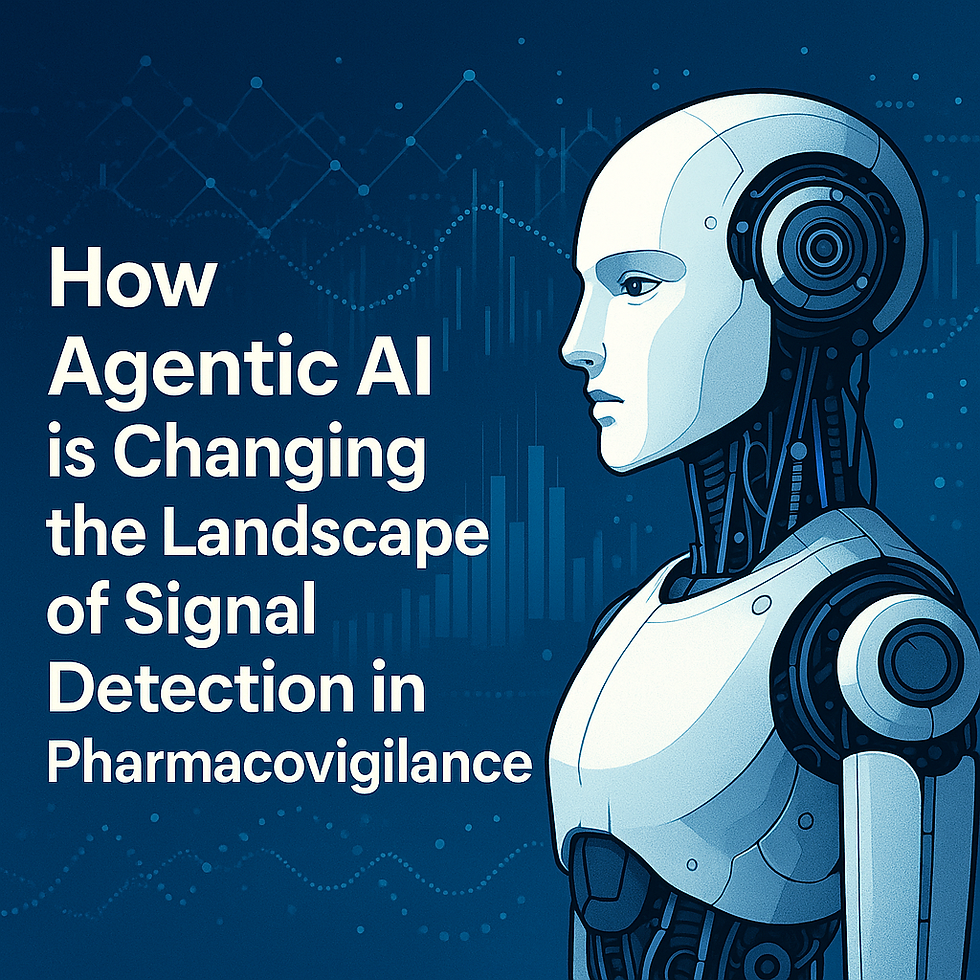How Agentic AI is Changing the Landscape of Signal Detection in Pharmacovigilance
- Chaitali Gaikwad
- May 2
- 4 min read

Signal detection is one of the most vital—and challenging—components of pharmacovigilance. It involves identifying new or rare adverse events or changes in the frequency of known events associated with drugs. The ability to detect signals early is crucial for mitigating risks, protecting patients, and complying with global regulatory requirements.
However, traditional signal detection methods often struggle to keep pace with the exploding volume and complexity of data. These limitations have paved the way for a revolutionary solution: Agentic AI.
Agentic AI brings a transformative approach to pharmacovigilance by enabling intelligent, autonomous, and adaptive systems that can detect drug safety signals with unprecedented speed, accuracy, and insight. In this blog, we explore how agentic AI is reshaping signal detection, enhancing safety outcomes, and enabling a new era of proactive pharmacovigilance.
What Is Signal Detection in Pharmacovigilance?
Signal detection is the process of identifying a potential causal relationship between an adverse event and a drug. These signals may emerge from spontaneous reports, clinical trial data, literature, social media, electronic health records (EHRs), or product quality complaints.
Common Challenges:
High Data Volume: Safety teams must analyze millions of records across different geographies and platforms.
Data Diversity: Inputs vary in format, structure, quality, and reliability.
Latency: Time-consuming manual analysis leads to delays in identifying crucial safety issues.
False Positives/Negatives: Inaccurate signals can either trigger unnecessary panic or miss genuine threats.
Traditional approaches, such as disproportionality analysis and Bayesian methods, offer statistical grounding but often lack contextual understanding and adaptability.
Introducing Agentic AI
Agentic AI refers to AI systems that exhibit autonomous, goal-driven behavior with the ability to understand context, learn from interactions, and make independent decisions. Unlike narrow AI, which requires explicit instructions, agentic AI adapts to new data and changing environments—making it ideal for complex tasks like signal detection.
Core Capabilities:
Autonomy: Acts independently based on predefined goals (e.g., early detection of ADRs).
Context Awareness: Understands the clinical and regulatory context of safety data.
Learning and Adaptation: Continuously improves performance through feedback.
Explainability: Provides reasoning behind detected signals, supporting regulatory compliance.
How Agentic AI Enhances Signal Detection
1. Advanced Pattern Recognition Across Multisource Data
Agentic AI can ingest and analyze structured and unstructured data from:
Spontaneous reporting systems
EHRs and clinical databases
Scientific literature
Social media and forums
Patient registries
Using NLP and machine learning, it identifies subtle patterns and associations that traditional algorithms might overlook.
Example: Detecting an uptick in liver toxicity in patients taking a specific formulation of a drug—across spontaneous reports and EHRs—even if the symptom terminology varies across sources.
2. Real-Time Surveillance and Early Warning
Traditional pharmacovigilance often operates with a time lag between event reporting and signal identification. Agentic AI enables real-time monitoring by:
Continuously analyzing incoming data streams
Flagging anomalies or unexpected patterns
Sending alerts based on dynamic thresholds
Impact: Early intervention, faster label updates, and proactive risk mitigation strategies.
3. Reduction of False Positives and Negatives
False positives (noise) and false negatives (missed signals) are critical pain points. Agentic AI mitigates these by:
Combining statistical methods with semantic analysis
Assessing signal strength using historical context
Learning from expert feedback to refine detection models
This leads to greater precision and higher confidence in signal outputs.
4. Signal Triaging and Prioritization
Agentic AI doesn’t just detect signals—it prioritizes them. Using a combination of factors (seriousness, population impact, reporting frequency, clinical relevance), it:
Scores signals by urgency and risk
Categorizes them (new vs. known, serious vs. mild)
Routes them to appropriate safety teams for escalation
This helps organizations focus on actionable insights rather than getting buried in data.
5. Integrated Causality Assessment
One of the key differentiators of agentic AI is its ability to go beyond correlation to support causality analysis. It considers:
Temporal association
Biological plausibility
Dechallenge/rechallenge outcomes
Dose-response relationships
Co-medications and confounders
Agentic AI evaluates these factors holistically, often presenting a confidence level or causality index to aid human decision-making.
Regulatory Alignment and Trust
Regulators like the FDA, EMA, and PMDA are increasingly supportive of AI in pharmacovigilance—as long as transparency, explainability, and validation are maintained.
Agentic AI Compliance Features:
Audit Trails: Tracks every signal and decision made by the AI.
Explainability: Provides narrative justifications or logic trees behind flagged signals.
Validation Protocols: Allows retraining and cross-validation with real-world data.
Data Privacy: Ensures compliance with HIPAA, GDPR, and data residency laws.
These features ensure agentic AI systems can stand up to scrutiny during inspections and safety audits.Challenges and Considerations
While the benefits are significant, deploying agentic AI requires careful planning.
Key Challenges:
Data Quality: Garbage in, garbage out. AI systems rely on clean, representative data.
Model Bias: AI may learn unintended patterns if not regularly audited.
Change Management: Safety teams must be trained to trust and understand AI recommendations.
Integration Complexity: Legacy systems may require restructuring to accommodate AI.
These are not deal-breakers—but must be addressed for successful implementation.
Conclusion
Agentic AI is not just a technological upgrade—it’s a paradigm shift in how pharmacovigilance operates. By enabling intelligent, autonomous, and adaptive signal detection, agentic AI helps organizations move from reactive monitoring to proactive, preventive pharmacovigilance.
The result? Faster detection of emerging risks, improved patient safety, reduced regulatory risk, and empowered pharmacovigilance professionals.
As data continues to grow in volume and complexity, agentic AI will be the backbone of next-generation safety systems—turning insight into action and transforming the future of drug safety.




Comments